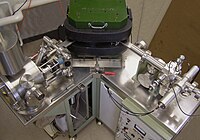
Photo from wikipedia
Abstract Cu isotope characterization of copper-based artifacts is a powerful tool used in recent decades to investigate the types of ore smelted in ancient metal production. Within a larger sample… Click to show full abstract
Abstract Cu isotope characterization of copper-based artifacts is a powerful tool used in recent decades to investigate the types of ore smelted in ancient metal production. Within a larger sample set, Powell et al. (2017) have identified a shift from positive δ 65 Cu values obtained for Eneolithic artifacts in the Balkans (5000–3600 BC) to more moderate and negative δ 65 Cu values of Bronze Age artifacts (2500–1000 BC), with a so-called “copper hiatus” between these two periods. Powell et al. concluded that accessible oxidized ore sources in this region were totally exhausted by the end of the Eneolithic period, directly leading to a “hiatus” in copper production. After the “hiatus”, starting with the Early Bronze Age, they proposed that sulfide ores were smelted using the Mitterberg process. The current paper addresses some weaknesses of the arguments put forth by Powell et al. and instead argues that Cu isotope ratios must be jointly considered with additional archaeometallurgical and archaeological investigations. Selective changes in preference for metal alloys likely affected the Cu isotope composition. Metallurgical operations using distinct Cu isotope reservoirs can alter the univariate Cu isotope ratio ( 65 Cu/ 63 Cu). Key points that must be considered are the transition from pure copper in the Eneolithic to arsenical copper in the Bronze Age, the co-smelting of distinct ore types, and the co-melting of metals derived from multiple smelting operations or from re-used metal artifacts. Moreover, there is no archaeological evidence for the Mitterberg smelting process in the Balkans during the Early Bronze Age.
Journal Title: Journal of Archaeological Science
Year Published: 2018
Link to full text (if available)
Share on Social Media: Sign Up to like & get
recommendations!